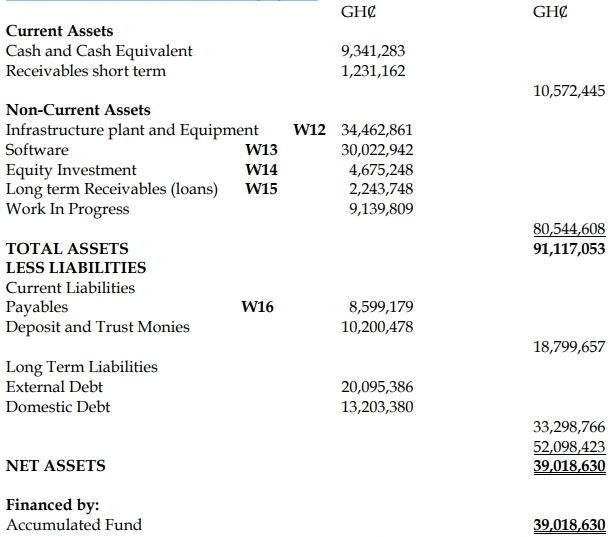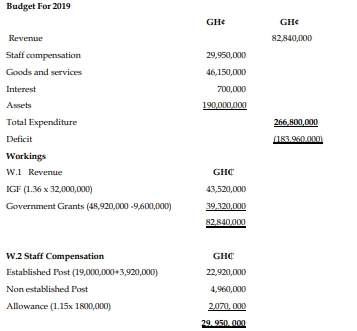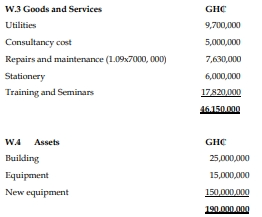- 20 Marks
Question
a) The Public Financial Management Regulation, LI 2378 defines Public Financial Management (PFM) as laws, rules, systems, and processes used by the Government to mobilize revenue, allocate public funds, undertake public spending, account for funds, and audit results. In 2001, a group of development partners initiated the Public Expenditure and Financial Accountability (PEFA) framework to assess the status of public financial management at central and local government levels. Since then, Ghana has subjected itself to periodic assessments in an attempt to improve the country’s PFM system.
Required:
i) Discuss FOUR (4) benefits the use of the PEFA framework can bring to a country. (6 marks)
ii) Explain FOUR (4) sources of information for PEFA assessment. (4 marks)
b) Budget Performance Report is one of the major accountability provisions under the Public Financial Management laws. Regulation 215(2) of the Public Financial Management Regulation, 2019, LI 2378 provides that each Principal Account Holder shall not later than 31 March of the ensuing year submit an annual budget performance report to parliament. The following is an extract from the GIFMIS platform representing Government of Ghana funding for the Ministry of Sanitation for the year 2023.
| Budget Item | Annual Appropriation (GH¢’000) | YTD Warrant (GH¢’000) | YTD Payments (GH¢’000) |
|---|---|---|---|
| Compensation of Employees | 25,500 | 18,280 | 17,450 |
| Goods and Services | 5,000 | 3,450 | 3,400 |
| Capital Expenditure | 8,780 | 1,220 | 550 |
| Total | 39,280 | 22,950 | 21,400 |
Required:
i) Explain the meaning of Annual Appropriation and YTD Warrant to the Principal Account Holder of the ministry. (2 marks)
ii) Enumerate TWO (2) issues that should be specified in the Annual Budget Performance Report to be submitted by the Principal Account Holder according to the Regulations 215 of LI 2378. (2 marks)
iii) Prepare a Statement of Budget Performance Report for the year 2023 showing the budget-warrant outturns and warrant utilization rates. (3 marks)
iv) Interpret the budget performance statement in (iii) above to facilitate the Minister’s upcoming meeting with the select committee of parliament as required under the law. (3 marks)
Answer
a)
i) Benefits of the PEFA framework to countries:
- Assessment of PFM Performance: The PEFA framework provides a standardized methodology for assessing the performance of a country’s public financial management system. By conducting PEFA assessments, countries can identify strengths and weaknesses in their PFM systems, enabling them to prioritize reforms and improve accountability and transparency.
- Basis for Reform Planning and Prioritization: PEFA assessments serve as a diagnostic tool for governments, helping them identify areas for improvement in their PFM systems. Based on the findings of the assessment, countries can develop action plans and prioritize reforms to address deficiencies and strengthen financial management practices.
- Monitoring and Evaluation of Reform Progress: The PEFA framework allows countries to monitor and evaluate the progress of PFM reforms over time. By conducting periodic PEFA assessments, governments can track improvements in PFM performance, measure the effectiveness of reform initiatives, and adjust strategies as needed to achieve desired outcomes.
- Enhanced Donor Coordination and Support: PEFA assessments provide a common language and set of benchmarks for donors, governments, and other stakeholders involved in supporting PFM reforms. By aligning donor assistance with the findings of PEFA assessments, countries can ensure that reform efforts are coordinated, targeted, and effectively implemented.
- Promotion of Transparency and Accountability: The PEFA framework promotes
transparency and accountability in public financial management by providing a
systematic approach for assessing the integrity, reliability, and timeliness of fiscal
information. By enhancing the credibility of financial reporting, PEFA assessments
contribute to greater trust and confidence in government institutions. - Capacity Building and Institutional Strengthening: Through the process of
conducting PEFA assessments and implementing reforms, countries can build the
capacity of government institutions and officials involved in financial
management. By strengthening institutional capacity, countries can improve their
ability to manage public resources efficiently and effectively. - International Benchmarking and Comparison: PEFA assessments allow
countries to benchmark their PFM performance against international standards
and best practices. By comparing performance indicators with peer countries,
governments can identify areas of relative strength and weakness, learn from
successful experiences and adopt innovative approaches to PFM reform.
ii) Sources of information for PEFA assessment:
- Legislation: Government financial management laws and regulations provide the legal framework for public financial management and are a primary source of information for PEFA assessments.
- Government Policy Papers: These documents outline government strategies, policies, and priorities, which can offer insights into the PFM environment.
- Budget Documents: The annual budget and related financial documents provide critical data on planned and actual revenue, expenditure, and financing activities.
- Reports and Statistics: Official reports and statistics, including those from national statistical agencies, provide quantitative data necessary for assessing PFM performance.
- Recent surveys.
- Analytical work at national, regional or international levels.
- Interview of key stakeholders.
b)
i) Meaning of Annual Appropriation and YTD Warrant:
- Annual Appropriation: This refers to the total amount of money that has been authorized by Parliament to be spent by a covered entity during the fiscal year. It represents the maximum budgetary allocation permitted for expenditure.
- YTD Warrant: Year-to-date (YTD) Warrant refers to the amount that has been approved by the Ministry of Finance for release from the Annual Appropriation. It is the actual amount made available to the entity for spending up to the reporting date.
(1 mark each = 2 marks)
ii) Issues to be specified in the Annual Budget Performance Report:
- Achievements of the Covered Entity: A summary of what has been accomplished in relation to the goals and objectives set for the fiscal year.
- Annual Work Plan: Details of the planned activities and projects for the year, along with any deviations or modifications.
(Any 2 points @ 1 mark each = 2 marks)
iii) Statement of Budget Performance Report for the year 2023:
| Budget Item | Annual Appropriation (GH¢’000) | YTD Warrant (GH¢’000) | YTD Payments (GH¢’000) | Budget-Warrant Outturn (GH¢’000) | Warrant Burn Rate (%) |
|---|---|---|---|---|---|
| Compensation of Employees | 25,500 | 18,280 | 17,450 | 7,220 (28.31%) | 95% |
| Goods and Services | 5,000 | 3,450 | 3,400 | 1,550 (31.00%) | 99% |
| Capital Expenditure | 8,780 | 1,220 | 550 | 7,560 (86.10%) | 45% |
| Total | 39,280 | 22,950 | 21,400 | 16,330 (41.57%) | 93.25% |
(3 marks evenly spread using ticks)
iv) Interpretation of Budget Performance:
- Budget-Warrant Outturn: The overall budget performance shows that 41.57% of the ministry’s budget was not released by the government. This would likely impact the ministry’s ability to fully implement its planned activities, especially in capital expenditures, which had the lowest release rate at only 13.9%. The non-release of a significant portion of the budget may have constrained the ministry’s service delivery and project execution.
- Warrant Burn Rate: Despite the limited releases, the ministry managed to utilize 93.25% of the total warrants issued, with a near-complete utilization rate for Goods and Services at 99%. However, the Capital Expenditure category showed a significant underutilization, with only 45% of the released funds being spent. This suggests potential delays in project execution or issues with the procurement process.
- Uploader: Joseph



